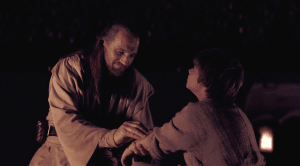I used to know how the Force worked. It was well defined in the original ‘Star Wars’ Trilogy as an energy field living things create and can manipulate. Individuals could use the Force in a variety of ways, often manifesting as powers, but it wasn’t an easy task. It required a deep faith and focus that one best comes by through intense training. We knew this by following the journey of Luke Skywalker from farm boy to powerful Force user under the tutelage of both Obi-wan Kenobi and Master Yoda.
Then the prequels came out, further underlining the idea that training was the gateway to the Force. We saw the Jedi train a small army of Force-users until their numbers were decimated by war prompted by the Sith. The Sith likewise showed that the ability to use the Force could be taught, albeit on a smaller scale. They submitted to the Rule of Two that said only one apprentice could be taught by the master at a time. There was, however, a new wrinkle introduced in ‘The Phantom Menace.’ Enter midi-chlorians! They were essentially cells within the blood that determined how likely one was to access the Force and made the select few much more likely to become Jedi than the rest of us. The concept made Luke’s line to his sister “the Force is strong in my family” objectively true and set up the Skywalker lineage as Force-sensitive forevermore. Midi-chlorians were not well received.
 There are two conclusions one could make from the failure of midi-chlorians. The first is that audiences don’t want to hear about the technicalities of what is essentially magic. We get that the Force exists, who cares about the details? That seemed to be the takeaway for director J.J. Abrams with the release of ‘The Force Awakens’, a story that continued the idea that lineage matters with the reveal that the movie’s big Force-user was the son of Princess Leia. Abrams also hinted that the other Force-sensitive character, Rey, also had important parents.
There are two conclusions one could make from the failure of midi-chlorians. The first is that audiences don’t want to hear about the technicalities of what is essentially magic. We get that the Force exists, who cares about the details? That seemed to be the takeaway for director J.J. Abrams with the release of ‘The Force Awakens’, a story that continued the idea that lineage matters with the reveal that the movie’s big Force-user was the son of Princess Leia. Abrams also hinted that the other Force-sensitive character, Rey, also had important parents.
The second conclusion for the dislike of midi-chlorians is that fans did not want the Skywalkers to be special. This seems to be what ‘The Last Jedi’ director Rian Johnson went with. His story threw out the idea that Rey’s parents matter with her adversary explicitly spelling that out.”You came from nothing,” Kylo Ren said. She isn’t special because of her parents, but she is special nevertheless. Rey may not be what the Internet calls a “Mary Sue” (an unrealistically perfect character) but Force-sensitivity is absolutely not distributed fairly in the film. Finn and most every other character can not levitate so much as a blaster while Rey can throw around boulders. To credit Johnson with “democratizing the Force” because he showed some kid floating a broom is nonsense. There is no reason to think everyone has equal access to the Force. A small on-screen group is blessed with powers just like Rey while Rose, Holdo, and the billions nameless go without.
Where does that leave us? We start with training being the key to the Force, move on to the Force being a feature of good genetics, to…what? Luck of the draw?
Fictional universes are only as strong as the rules they follow. The Force is, well, a force of nature in ‘Star Wars’. It’s like gravity or electromagnetism – how it works should be the one thing consistent throughout all ‘Star Wars’ films. Characters and tech can change, the Force can not. Say what you want about midi-chlorians, but they did not throw out what came before. Jedi still needed training, they just then needed training and a bloodline, which could have always been the case. Going into ‘Episode IX,’ one just needs to win the universal lottery to become a Jedi, which makes everything a little less ‘Star Wars.’

